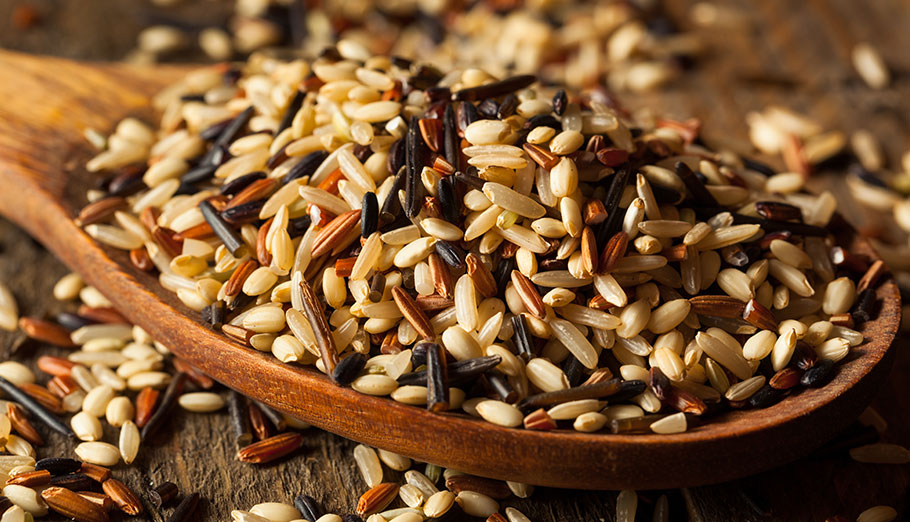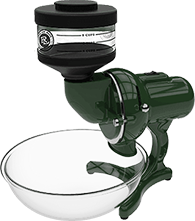Wild Rice

Overview
Wild rice is not actually a type of rice. It’s a type of grass that grows in shallow water, 2 to 4 feet deep. Originally from north-central North America, other varieties of wild rice are found all across the U.S. and in parts of Asia. Native Americans harvested wild rice by knocking ripe seeds into their canoes with sticks. In Minnesota, uncultivated wild rice is still harvested in this manner by licensed professionals.
Native Americans would parch the seeds in a pot over an open flame before packing them into birch bark baskets. Modern wild rice farmers use mechanical methods to dry the kernels and remove the hulls.
Wild rice is difficult to grow and cultivate, resulting in a higher cost. Often, wild rice is sold mixed with white rice, brown rice and other grains to reduce the price. When ground into flour, wild rice adds a hearty, nutty flavor to baked goods, such as muffins and pancakes.
Nutrition
Wild rice has twice as much dietary fiber and protein as brown rice. It is also an excellent source of folate, magnesium, phosphorus, manganese, zinc, vitamin B6, niacin and antioxidants.
Note: Weight of a cup (or partial cup) of flour varies depending upon whether it is lightly sprinkled into a measuring cup or compacted. Most recipe measurements are based on sifted flour as a way to arrive at more uniform measurement.
Gluten Content & Allergen Information
Wild rice is naturally gluten-free, although many wild rice mixes include other ingredients which contain gluten. Those with Celiac disease or gluten intolerance can safely enjoy wild rice flour as long as the wild rice was not combined with gluten-containing ingredients. Wild rice allergies are extremely uncommon, although sensitivities do occur.
Nutrition Facts
| Serving Size | 1 Cup |
| Calories | 571 |
| Total Fat 2g | 3% |
| Cholesterol 0mg | 0% |
| Sodium 11mg | 1% |
| Carbohydrates 120g | 40% |
| Dietary Fiber 10g | 34% |
| Total Sugars 0g |
| Protein 24g |
| Vitamin D 0mcg | 0% |
| Calcium 34mg | 3% |
| Iron 3mg | 17% |
| Potassium 0mg | 0% |
* The % Daily Value (DV) tells you how much a nutrient in a serving of food contributes to a daily diet. 2,000 calories a day is used for general nutrition advice.
Diet Compatibility
Paleo Diet
The Paleo Diet seeks to emulate the hunter-gatherer diet of our stone-age ancestors. The emphasis is on wild plants and meats similar to what ancient man would have consumed. As such, dairy products, refined sugar and processed oils are off limits. While many Paleo Diet followers also avoid grains, there is ample archaeological evidence to show that grains were part of Paleolithic era man’s diet.
Compatibility with Wild Rice Flour:
Compatible

Mediterranean Diet
This diet seeks to emulate the diets of those living along the Mediterranean coast, with an emphasis on fresh fruits and vegetables, seafood/fish at least twice a week, limited servings of poultry, and only occasional sweets and red meat.
Compatibility with Wild Rice Flour:
Compatible

Gluten-Free Diet
As the name suggests, the gluten-free diet eliminates all foods with gluten. Although most of those on a gluten-free diet are on it out of necessity—either due to severe wheat allergies or Celiac disease—many have embraced a gluten-free diet as being healthier.
Compatibility with Wild Rice Flour:
Compatible

Macrobiotic Diet
Although there are many versions of macrobiotic diets, the common thread is that they emphasize natural, whole foods, grown locally and organically. Whole grains, vegetables, legumes, fruits, seeds and nuts, and occasional seafood are all integral to the diet. Red meats, dairy, poultry, eggs and processed foods are off the menu.
Compatibility with Wild Rice Flour:
Compatible

Acid Alkaline Diet
This diet aims to restore the slightly alkaline state of the body, which is believed to be ideal. By focusing on a diet high in vegetables, fruits, sprouted grains, lentils, almonds and soy products, the goal is to have a balance of 80% alkalizing foods and 20% acid forming foods.
Compatibility with Wild Rice Flour:
Compatible – Wild Rice Flour is considered to be slightly Alkaline

Low-Carb Diet
As the name suggests, this diet focuses on reducing carbohydrates in the diet to lose weight. The theory is that by staying away from high-carb foods like pasta and bread and eating low carb, high fiber vegetables and fruits instead, your body will go into ketosis and you will lose weight. This diet is sometimes referred to as a ketogenic diet.
Compatibility with Wild Rice Flour:
Compatible in small amounts

Atkins Diet
The Atkins Diet is a historically popular low carb diet, instructing dieters not to worry about their calories but to monitor and minimize their intake of sugar and carbohydrates. According to Dr. Atkins, depriving the body of its primary energy sources causes the body to burn fat.
Compatibility with Wild Rice Flour:
Compatible in small amounts

“We love the mill! We use it every day for things from bread, to pastry and it is phenomenal. The biggest selling point for me was the fineness since that would mean we can really do some great pastry with it in addition to bread. It definitely has been great!"
BEN FROM NORTH CAROLINA

